
Every evening our headlined provide snapshots from two major media outlets on each side of the left-right news spectrum that reflect topics that influence or move investor sentiment. In moments on this business evening report, you can get insights-at-a-glance.
This report also sets the broader context for manufactured housing markets, in keeping with our mantra, “News through the lens of manufactured homes and factory-built housing” ©.
We begin with left-of-center CNN followed by right-of-center Fox Business. We share closing tickers and other related data courtesy of Yahoo Finance, and more. 5 to 10 minutes reading this MHProNews market report every business night could save you 30 minutes to an hour of similar reading or fact-gathering elsewhere.
Headlines from left-of-center CNN Business.
· A never-ending trade war
· As new tariffs kick in, the world is watching to see what happens next between the US and China
· Americans are growing more worried about the trade war. That’s bad news for the economy
· Tariffs are about to become a big problem for the maker of iconic Smith & Wesson firearms
· August was the second-worst month of the year for stocks
· Siemens just borrowed billions. Its corporate bonds had the lowest yields ever
· Apple is making it easier to get your iPhone fixed at more places
· Google reportedly agrees to pay at least $150 million to settle FTC probe into YouTube
· Why Amazon bought a piece of the Yankees’ TV network
· United extends flight cancellations due to 737 Max
· Popeyes CEO: We made one mistake with chicken sandwich
· Pokémon Masters is the latest mobile game to draw heavily from console
· Scooters are becoming a logistical headache
· Shopping Content by CNN Underscored
· Samsung’s Galaxy Note 10+ is one of the finest phones on the market
· Jack Dorsey’s Twitter account was hacked — and he’s the CEO of Twitter
· The maker of Vans and Timberland will stop buying leather from Brazil amid Amazon fires
Headlines from right-of-center Fox Business.
· JACK IS HACKED: TWITTER CEO’S ACCOUNT SPEWS RACIST MESSAGES
· Uber, Lyft and DoorDash pledge $90M to fight this proposed law
· Consumers keep at it, spending strong
· Chicago faces $838M budget deficit, mayor says
· Trump signals support for indexing capital gains[overlay type]
· Trump signals support for indexing capital gains
· Ford issues frightening warning about 480,000 vehicles in US
· Waffle House Index: What it is and why FEMA watches it as Dorian approaches
· Candymaker says hacker may have stolen customer credit cards
· Juul’s bad week just got even worse
· US needs more immigrants to boost economy, says JP Morgan strategist
· The biggest threat to the elderly as Hurricane Dorian nears
· Dorian force may rock Star Wars land at Disney World
· Star Wars land in Florida’s Disney World bracing for hurricane Dorian.
· Hurricane Dorian: How people can financially prepare for the worst
· “Everyday Millionaires” author Chris Hogan on Thursday explained how people can prepare for a severe storm.
· Continue to More on Hurricane Dorian
· Russia’s oil slip sends U.S. prices down as Hurricane Dorian threat looms
· Your 401(k) is a better indicator of how well the Trump economy is really doing: Varney
· Trump singles out GM for moving plants to China
· Some Democrats want a ‘wealth tax,’ what you should know
· Why millennials are drinking less beer and sipping more wine, spirits
· As workers delay retirement, younger employees get stuck
· Why Netflix is trolling USC over its admissions scandal
· Hurricane season’s devastating toll
· Hong Kong pro-democracy activists arrested, weekend protests canceled
· Counterfeit-stamped gold found in JPMorgan vaults, global markets: Report
· Beyond Meat craze, demand for plant-based foods boosts meatless job market
· Billionaire Tom Steyer’s tax returns reveal massive fortune
10 Market Indicator Closing Summaries – Yahoo Finance Closing Tickers on MHProNews…

Tonight’s Business/Market/Political Impact Spotlight –

In the third-party transcript that follows, we’ve corrected a few typos, and spared reader/investors some of the normal disclosures that are used to reading. There will be links and downloads to more information that are part of the bigger picture you won’t find anywhere else.
First, to tee up the transcript. According to Legacy Housing’s IR page:
Financial Highlights:
- Revenue for the second quarter of 2019 was $45.8 million, compared to $44.0 million in the second quarter of 2018, an increase of $1.8 million or 4%.
- Gross margin percentage increased to 29.9% from 23.2% from the prior year as a result of price increases, increased sales to manufactured home parks, and increased company-owned retail sales directly to consumers.
- The manufactured home park loan portfolio increased by $14.1 million to a total of $72.0 million, an increase of 24% from the end of 2018. The consumer loan portfolio increased to $101.0 million, inclusive of the allowance for loan loss and other discounts.
- Earnings before taxes grew $2.5 million or 28% to $11.4 million in the second quarter compared to the prior year quarter. Net income was $8.6 million in the second quarter of 2019, compared to $6.9 million for the comparable period in 2018, a 25% increase in net income.
- The Company’s revenue and net income increases came exclusively from organic growth.
- Earnings per share for the second quarter of 2019, based on diluted weighted average shares outstanding, was $0.35 on 24,369,890 diluted outstanding shares versus $0.34 on 20,000,000 outstanding shares for the comparable quarter in 2018. The increase in shares reflects those shares sold pursuant to the Company’s successful initial public offering.
About Legacy Housing Corporation
Legacy Housing Corporation builds, sells and finances manufactured homes and “tiny houses” that are distributed through a network of independent retailers and company-owned stores and are sold directly to manufactured housing communities. We are the fourth largest producer of manufactured homes in the United States as ranked by number of homes manufactured based on the information available from the Manufactured Housing Institute. With current operations focused primarily in the southern United States, we offer our customers an array of quality homes ranging in size from approximately 390 to 2,667 square feet consisting of 1 to 5 bedrooms, with 1 to 3 1/2 bathrooms. Our homes range in price, at retail, from approximately $22,000 to $120,000.
As a disclosure, MHProNews has provided periodic event promotion for Legacy Housing in 2018 and in 2019. Legacy’s marketing rep, with senior management authorization, said the following.
That disclosure noted, let’s turn to their recent investor transcript, which follows the graphic. While serious investors and industry professionals will want to read every word, the pull-quotes below may be among the statements that are particularly worth noting, with terminology as in the original.
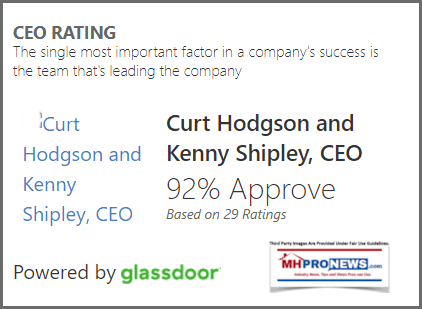
· Year-over-year, our sales to parks almost doubled
· …is a decrease of sales in 2019 through independent retailers. This change in our distribution mix is not without its benefits because parks and company-owned retail stores have higher prices and higher margins.
· Overall, we had a strong second quarter with revenue of $45.8 million, compared to $44 million in the second quarter of 2018. Considering the industry as a whole has underperformed last year, we think Legacy’s top-line number is good.
· We now own four properties targeted for development — two in the Austin market, one in the Fort Worth market, and one in the San Antonio market.
· We’ve also provided financing to three developers of mobile home parks and are in the process of closing loans currently to two additional developers.
· …we again experienced exceptional growth in our sales to manufactured home communities, which increased $8.5 million, or 93%, to $17.6 million.
· The shift in product sales to manufactured home parks and sales through our retail stores, combined with annual price increases, drove the margin improvement.
· And we’re all kind of shucking and jiving, trying to figure out how to satisfy the demand for affordable housing through other distribution systems and the traditional independent retailer.
· I think as long as the projects are in our core market area of the southeast and southwest, we could probably go all the way to 20 projects of reasonable size that we have a financial involvement in without stretching the limits.
· But within the next two or three years, I wouldn’t be surprised if 30-40% of our production is going to development projects in our market areas.
· There’s about three or four new factories year-over-year around the United States, while shipments around the United States are down maybe 5-10%. I think the reason they were down, or some of the reason we see in the call — but we’re also running into a place-to-put-them problem in the major metropolitan areas in our market.
· And those that aren’t are going to suffer.
· It’s simply a place to put them in the metropolitan areas. That issue just has to be remedied.
· As far as new [GSE] financing coming on board, even if they decreased our payments by $100 or $200 dollars because the interest rate went down, it wouldn’t solve the fundamental problem of a place to put them.
· …relatively new player here, but I will say that we — in our sales to the mobile home communities, and through our company owned stores, those sale prices are significantly higher than through the dealers.
· I think the model of selling wholesale and then forgetting about it is over. I think we’ll all be more involved with the end user than we have been in the past.
· We’ll be involved in communities. We’ll offer more high margin things, like maybe carports, for instance, which was recently OKed by the Feds.
· There’s also a shift toward a medium end product and away from a low end product.
· And I think that — basically, if we sell it wholesale for $60,000, we sell it retail for $90,000. That’s basically — I know it seems higher margin than what most people would think, but there’s about a 50% markup between wholesale and retail for our product.
· So, no one was contemplating where we are today, that mobile home parks would be full and would be renting spaces for $600 or more per month. The response to that has been very slow from the industry.
· And until development occurs of more places to put them, we’re all stymied in trying to sell product into those full markets.
· …– I think the — we’re probably a year and a half into the big one in Del Valle, which will be well over 1,000 mobile homes.
· Our industry is full of people that don’t think very far out.
· And Legacy’s view is, we have to address all of those concerns and more to be effective in the affordable housing market.
· We’re going to take on the homebuilders head on in our key markets and see if indeed somebody wants a $129,000 all-in product as opposed to a $220,000 product that the site built housing people are doing.
· You guys seem like a fantastic combination. Kenny, you’re fantastic in the sales department. And then, Curt, I guess engineering.
Their Legacy transcript will be followed by some commentary and analysis, and links to more reports.
Legacy Housing Corporation (NASDAQ: LEGH)
Q2 2019 Earnings Call
August 14, 2019, 11:00 a.m. ET
Contents:
· Prepared Remarks
· Questions and Answers
· Call Participants
Prepared Remarks:
Operator
Good day, ladies and gentlemen, and welcome to the Legacy Housing Corporation Second Quarter 2019 Earnings Conference Call. At this time, all participants are in a listen-only mode. Later, we will conduct a question-and-answer session, and instructions will follow at that time. If anyone should require assistance during the conference, please press * then 0 on your touch-tone telephone. As a reminder, this conference call may be recorded.
I would now like to introduce your host for today’s conference, Mr. Curt Hodgson, Executive Chairman of the Board. Sir, you may begin.
Curtis D. Hodgson — Executive Chairman of the Board & Co-Founder
Thank you for joining the call today. Before we begin, may I remind our listeners that management’s prepared remarks today will contain forward-looking statements which are subject to risk and uncertainty, and management may make additional forward-looking statements in response to your questions. Therefore the company claims the protection of the Safe Harbor for forward-looking statements that is contained in the Private Securities Litigation Reform Act of 1995. Actual results may differ from management’s current expectations, and therefore, we refer you to a more detailed discussion of the risk and uncertainties in the company’s annual report filed with the Securities and Exchange Commission.
In addition, any projections as to the company’s future performance represents management’s estimates as of today’s call. Legacy Housing assumes no obligation to update these projections in the future unless otherwise required by applicable law.
With those preliminary remarks out of the way, the first thing I want to do on the call today is welcome Cork Van Den Handel, our new CFO, to his inaugural earnings call with Legacy. As part of our growth initiatives as a public company, we wanted to bring in a CFO with great analytical abilities, public company experience, and a background that includes strategic and operational expertise. We found all those qualities and more in Cork, and I am excited about the value he adds for Legacy and our shareholders.
I also want to take a moment to thank Jeff Burt for his transition into the role of Chief Accounting Officer. Jeff has been a critical part of Legacy’s success over the last decade and now, with Cork’s and Jeff’s leadership, we have a dynamic team assembled to lead Legacy’s accounting and financial reporting team into the next phase of Legacy’s future.
Now, let me turn to a discussion of our view of the industry, our second quarter performance, and provide some additional updates on key projects. I will then turn the call over to Cork to introduce himself, and to discuss the financial results in more detail.
We continue to believe that demand for affordable housing is strong and that our industry is a critical and necessary part of the solution to the affordable housing crisis. We have seen stabilization of demand over some choppy waters at the end of 2018 and continuing into the first quarter of this year. Manufactured housing shipments in 2019 are still not quite tracking to the levels of shipments of last year, but we do not view this as indicative of a long-term industry trend, or having significant impact on Legacy for this year. The softening demand due to retailer inventory destocking and short-term weather related events, we view as more of an aberration than a red flag.
While Cork will provide more financial detail, there are certain trends in our financials that I think are important to note. First, we continue to see significant growth in our sales and financing activities to manufactured home parks or communities. Year-over-year, our sales to parks almost doubled. The fact that mobile home parks are investing in product is strong evidence of the fundamental role manufactured housing is playing in providing affordable housing. Likewise, the manufactured park home portfolio increased by $14 million to a total of $72 million, and an increase of 24% from the end of last year.
Another trend we’re seeing is increased sales through our company-owned retail stores, which in part explains our great margins this quarter and so far this year. I’m pleased to announce that we’re opening an additional tiny home outlet in the Atlanta area. This new store is under lease. It should be opening its doors to the public tomorrow.
The other trend we have seen — and it’s one we spoke about on the Roadshow — is a decrease of sales in 2019 through independent retailers. This change in our distribution mix is not without its benefits because parks and company-owned retail stores have higher prices and higher margins. If you take those factors, combined with some price increases that we implemented in the last 12 months, our average sales prices have increased year-over-year from around $40,800 to approximately $44,600, an increase of over 9%. Similarly, our gross margin increased to 29.9% from 23.2% from the same period last year.
Overall, we had a strong second quarter with revenue of $45.8 million, compared to $44 million in the second quarter of 2018. Considering the industry as a whole has underperformed last year, we think Legacy’s top-line number is good. Earnings before taxes grew $2.5 million, or 28%, to $11.4 million in the second quarter compared to the same period last year. All of this growth was organic. Although we remain open to opportunities to grow the company if we can find the right partner for acquisition or collaboration, we thus far in the history of the company have not purchased any capacity in the industry.
We also continue to make progress on land development projects. That’s what I’d like to speak a minute about. Our largest feature project is in Del Valle, Texas, just outside of Austin. We still anticipate that project starting to show up in our revenue beginning in the first or second quarter of 2020. Projects like that should also ensure our production remains at or above current levels for the foreseeable future. We now own four properties targeted for development — two in the Austin market, one in the Fort Worth market, and one in the San Antonio market.
We’ve also provided financing to three developers of mobile home parks and are in the process of closing loans currently to two additional developers. We think that our role in mobile home park development will keep us ahead of the competition for many years to come.
I will now turn the call over to Cork so he can tell you a bit more about his background and experience and discuss the financials in more detail. Cork?
Cork Van Den Handel — Chief Financial Officer & Corporate Treasurer
Thanks, Curt. First, let me say that I’m delighted to be a part of the Legacy team. This is an excellent company with an exceptional management team, and is an innovator in its industry. My prior career spans a wide range of industries, from aerospace manufacturing, distribution, and engine overhaul, to business services, solar energy, and automotive retail. I have had CFO responsibilities in public, private equity owned, and entrepreneurial businesses, and I look forward to contributing to the continued success of Legacy Housing.
Moving to the financial review, net revenue for the second quarter of 2019 was $45.8 million, a 4% increase compared to net revenue of $44 million reported in 2018’s second quarter. As Curt noted, product sales are our largest component of revenue and we again experienced exceptional growth in our sales to manufactured home communities, which increased $8.5 million, or 93%, to $17.6 million.
Sales through our company owned retails stores increased 11% to $4.9 million, and these increases were partially offset, as Curt noted, by decreased sales of consigned inventory through our network of independent retailers and reduced factory direct sales. Product sales’ gross margin percentage increased 6.7 points to 29.9%, resulting in a $3 million increase in gross margin. The shift in product sales to manufactured home parks and sales through our retail stores, combined with annual price increases, drove the margin improvement.
Interest income in the quarter was $5.1 million, a 13% increase over the $4.5 million recorded last year. Our manufactured home park loan portfolio increased $14.1 million, or 24%, from the end of 2018 to $72 million, reflecting the significant growth Legacy is experiencing in sales to this market segment. The consumer loan portfolio principle balance increased $3.8 million net to $101 million, inclusive of the allowance for loan loss and other discounts.
SG&A expenses grew 19% to $6.1 million, primarily the result of increased expenses for our company owned retail stores and increase in our warranty reserves. Pretax earnings, as Curt noted, grew $2.5 million, a 28% increase, to $11.4 million in the quarter. Income tax of $2.8 million increased $700,000 over the second quarter of 2018. Net income was $8.6 million for the second quarter of ’19, compared to $6.9 million in the prior year period, an increase of 25%. Earnings per share based on basic and diluted weighted average shares outstanding was $0.35, compared to $0.34 in the prior year quarter. Finally, equity increased almost $20 million from year end 2018 to $209.2 million on our strong earnings performance in 2019. That completes our financial overview, Curt.
Curtis D. Hodgson — Executive Chairman of the Board & Co-Founder
Thanks, Cork. The second quarter results reflected the strong fundamentals of our company. And I think it’s safe to say we are in a time of some transition. Yet I view that as good for the long-term prospects for Legacy. We need to continue to execute our plan and the results will speak for themselves. As we emphasized during our Roadshow, our priority is to steadily increase book value over the long haul. Thank you for your interest and attention today.
…
And now, we’ll take any questions.
Questions and Answers:
Operator
Thank you. Ladies and gentlemen, if you have a question at this time, please press the * then the No. 1 key on your touch-tone telephone. If your question has been answered or you wish to remove yourself from the queue, please press the # key. Again, that’s * then 1 to ask a question. To prevent any background noise, we ask that you please place your line on mute once your question has been stated. Our first question comes from Alex Rygiel with B. Riley FBR. Your line is now open.
Alex Rygiel — B. Riley FBR, Inc. — Analyst
Curt and Kenny, nice quarter. And Cork, welcome aboard.
Cork Van Den Handel — Chief Financial Officer & Corporate Treasurer
Thank you.
Curtis D. Hodgson — Executive Chairman of the Board & Co-Founder
Thank you.
Alex Rygiel — B. Riley FBR, Inc. — Analyst
Curt, can you talk a little bit about the outlook for the second half of the year this year, understanding that the first half of the year had some strange demand characteristics with regards to weather and inventory adjustments? So, how should we think about third quarter and fourth quarter as it relates to maybe the run rate that you printed for net sales in the second quarter here?
Curtis D. Hodgson — Executive Chairman of the Board & Co-Founder
I think the industry as a whole took the last six months to decrease inventories. If you look at our financials, we’re not an exception of that. Our inventory, both finished good and raw material, went down. So, some of the contraction that you saw was a sell off of the inventory that was already in place. Anecdotally, we’ve got enough orders to run well through our show — our fall show. And our fall show usually gives us enough orders to run through the fourth quarter. So, I think it’s — I think we have the third and fourth quarter pretty well spoken for.
Overall, I think there’s still an issue with the way we distribute homes through independent retailers — not just us, but our competitors as well. And we’re all kind of shucking and jiving, trying to figure out how to satisfy the demand for affordable housing through other distribution systems and the traditional independent retailer. As for us, as you know, we are emphasizing community development near urban markets. We think that’s a place where we’re going to be. So, essentially, we’re getting more vertical and it’s probably going to keep our plans running indefinitely in the future because we’ll be supplying properties that we have a financial connection to. I hope that answers your question, Alex.
Alex Rygiel — B. Riley FBR, Inc. — Analyst
It sure does. Second question, as it relates to making progress on the land. It sounds like you own four lots, you have loans out to three others, and you’ve got two loans in process. Looks like that’s about nine in total. How many properties, or projects, do you think you can manage at one time? And does nine go to 12 in the next six months, or does nine go to 20 in the next 6-12 months?
Curtis D. Hodgson — Executive Chairman of the Board & Co-Founder
Well, I’ll take that one, too. I think as long as the projects are in our core market area of the southeast and southwest, we could probably go all the way to 20 projects of reasonable size that we have a financial involvement in without stretching the limits. The projects we currently have represent over 2,000 home sites, and probably closer to 3,000 section sites, as you will, because many of the sites are designed for doublewides. And we expect that those projects will contribute an ever increasing role in our production. It may be only 10% next year, maybe 15%. But within the next two or three years, I wouldn’t be surprised if 30-40% of our production is going to development projects in our market areas. We think there’s actually more profit opportunities doing that than there is expanding geographically. So, that’s why our focus is there.
We’re getting $500, $600, and sometimes even $1,000 a month for a place to park our product, but we’re only charging $500, $600, $700 when you buy our product. It’s an imbalance between the ratio between the cost of a place to put it and the product itself that we intend to get in there and help change the ratio a bit.
Alex Rygiel — B. Riley FBR, Inc. — Analyst
As you look at the broader landscape, other than the shifting dynamics of the independent retailers, are you seeing any other shifts in the macro, either from Fannie and Freddie getting involved, or interest rates, or competitors opening up new production facilities?
Curtis D. Hodgson — Executive Chairman of the Board & Co-Founder
I think I know the answer to this, but I wasn’t prepared for that question. There’s about three or four new factories year-over-year around the United States, while shipments around the United States are down maybe 5-10%. I think the reason they were down, or some of the reason we see in the call — but we’re also running into a place-to-put-them problem in the major metropolitan areas in our market. So, that’s why we’re attacking that. I think we’re all going to be faced with a place-to-put-it problem, and those people that are aligned with the developers or doing their own developments will be able to keep their top line up. And those that aren’t are going to suffer. So, that’s basically — I know that’s a repeat of what I said, but we’re seeing that it’s not the $600 a month mobile home payment that is causing a reduction in demand. It’s simply a place to put them in the metropolitan areas. That issue just has to be remedied.
As far as new financing coming on board, even if they decreased our payments by $100 or $200 dollars because the interest rate went down, it wouldn’t solve the fundamental problem of a place to put them. The GSEs are coming in to the — excuse me, GMOs are coming into the market very lightly with a very specialized product. And they’re going to have the same interest rates for manufactured housing that they do for site built housing. But the product that will qualify for that is going to be difficult to do for most manufactured housing plants. We’re all moving that direction. We like the new level of manufactured housing that is anticipated by these programs. But let’s see how it proves out before we get too excited about it.
Alex Rygiel — B. Riley FBR, Inc. — Analyst
One last question for Cork so he doesn’t get off too easy on this call. I heard a reference to an increase in warranty reserves and an increase in loan loss reserves. Can you comment on those two items?
Cork Van Den Handel — Chief Financial Officer & Corporate Treasurer
Actually, I talked about warranty reserves, and they were up, I think, about $200,000. It’s simply — I think it’s simply a matter of the fact that we’ve got a good deal of product out there. And as a result, we have greater exposure.
Alex Rygiel — B. Riley FBR, Inc. — Analyst
Fair enough. Thank you very much. Nice quarter.
Cork Van Den Handel — Chief Financial Officer & Corporate Treasurer
Thanks.
Operator
Thank you. And our next question comes from David Burdick with Oak Ridge. Your line is now open.
David Burdick — Oak Ridge Financial Services Group, Inc. — Analyst
Hey, guys. Thanks for taking my questions and congrats on the nice quarter.
Curtis D. Hodgson — Executive Chairman of the Board & Co-Founder
Thank you.
David Burdick — Oak Ridge Financial Services Group, Inc. — Analyst
First, I guess, just wanted to talk about these strong margins, which I believe were up about 600 BPS versus the prior year. You guys called out a few things in here, but is there anything really specific driving this? And then, is the 30% range something we should expect moving forward?
Cork Van Den Handel — Chief Financial Officer & Corporate Treasurer
Well, I’ll not comment on going forward right now as a relatively new player here, but I will say that we — in our sales to the mobile home communities, and through our company owned stores, those sale prices are significantly higher than through the dealers. And the margins that we get from them are significantly better. And so, what we’re seeing is a shift in the mix of business to the higher margin sales. Anything you’d like to add, Curt?
Curtis D. Hodgson — Executive Chairman of the Board & Co-Founder
Nah, I’ll try to give you the crystal ball going forward. I think the — I think all companies will see higher growth margin, but also higher SG&A facing that higher growth margin. I think the model of selling wholesale and then forgetting about it is over. I think we’ll all be more involved with the end user than we have been in the past. And in doing so, we’ll have company owned stores. We’ll be involved in communities. We’ll offer more high margin things, like maybe carports, for instance, which was recently OKed by the Feds. And I think you’re going to see more high margin product facing consumers. There’s also a shift toward a medium end product and away from a low end product. Our homes are much more optioned up today than they were a few years ago.
So, there’s a trend toward that. And as interest rates come down for our product, and they are even with what we do, the payments stay the same and the people get more product. Usually, they get it with the higher margin. The home itself is very low margin and then we start adding options and pertinences to it — the margin gets higher. And I think that — basically, if we sell it wholesale for $60,000, we sell it retail for $90,000. That’s basically — I know it seems higher margin than what most people would think, but there’s about a 50% markup between wholesale and retail for our product.
David Burdick — Oak Ridge Financial Services Group, Inc. — Analyst
That’s helpful. And then, can you guys just talk a little bit more about your strategy in the community development and why you think that’s so important to go in this direction? And then, also could you maybe help explain how the whole process works when it comes to timelines around breaking ground and first units coming online. I know the Austin development is pretty big and you guys mentioned those sales coming online in 2020 — early 2020. But just trying to get a timeline or expectations around some of those other smaller lots as well.
Curtis D. Hodgson — Executive Chairman of the Board & Co-Founder
Our industry hasn’t had a lot of community development for — really since the ’80s. So, when the two downturns in the industry happened in the ’80s and then again at turn of the century, when Greentree filed bankruptcy, the response to that — those downturns was to remove from the mobile home parks the mobile homes that were repossessed, creating all sorts of vacancy around the entire country. So, no one was contemplating where we are today, that mobile home parks would be full and would be renting spaces for $600 or more per month. The response to that has been very slow from the industry. If there were a lot of projects in development on the drawing boards, I think I would know about it because I’m in the front seat.
So, we think that is fundamental to the industry. There are plenty of spaces out in the country and in the small towns, but near big cities in Denver, or in Dallas, or Fort Worth, or San Antonio, or Atlanta, or Jacksonville — these are basically full markets. And until development occurs of more places to put them, we’re all stymied in trying to sell product into those full markets. Now, how does it work? Well, if we buy the land, and we engineer it ourselves, and we put in roads, and we put in water systems, it’s a 24- to 36-month process. So, that’s the lead time on it. So, when I said we have four of those properties, those four properties — I think the — we’re probably a year and a half into the big one in Del Valle, which will be well over 1,000 mobile homes. And we’re much younger in the other. So, basically, I don’t really see a significant lift in those endeavors until 2021 or beyond. But that is the direction.
Why do I think it’s that way? Our industry is full of people that don’t think very far out. And when we set a mobile home, we set it too high. We put skirting on it that isn’t durable and doesn’t look good. We don’t think about where the cars are going to park or carports. We don’t think about how the pet is going to get in and out of the mobile home into the backyard. So, we haven’t matured like the Pultes and the D.R. Hortons of the world. And Legacy’s view is, we have to address all of those concerns and more to be effective in the affordable housing market. And that’s the direction we’re going. We’re going to take on the homebuilders head on in our key markets and see if indeed somebody wants a $129,000 all-in product as opposed to a $220,000 product that the site built housing people are doing. That’s basically it.
To answer your question, the industry has not adequately addressed the entire package of affordable housing issues. The lumber, the roof, the house itself we’ve done a pretty good job on. Our product is staller. But the rest of the package that you get when you go buy a site built house, our industry has not done a very good job at addressing that. And that’s why we think the opportunity is now to do that. I don’t know if that answers your question. I know it was longer than I wanted, but — I gave a 30-minute speech on the same issue about three weeks ago.
David Burdick — Oak Ridge Financial Services Group, Inc. — Analyst
No, that’s helpful, and sounds like a significant opportunity. So, yeah, that’s for taking my questions, guys. And good luck in the second half.
Curtis D. Hodgson — Executive Chairman of the Board & Co-Founder
Thank you.
Operator
Thank you. As a reminder, ladies and gentlemen, that’s * then 1 to ask a question. Our final question comes from David Mercer, an investor. Your line is now open.
David Mercer — Investor
Hey. Good job, guys. It looks like you guys are doing a good job. This is for Cork. How is it, in your past track record that you’ve done and been successful, to make us believe you can be an asset for Legacy? Have you worked for companies that you’ve brought earnings from this to this in so many years? Or have you had your own company? What track record have you had that shows that your success will help Legacy grow its company?
Cork Van Den Handel — Chief Financial Officer & Corporate Treasurer
That’s a good question, David, and I appreciate you asking that. I’m not going to go through my entire career because I think people have better things to do than fall asleep listening to me talk, but I will point that after we took over the roles at — the new management team took over the roles at Aviall, we managed to grow the company in about six years from about $300 million in revenue to about — well, to over $1 billion. We did that by changing the way the aviation distribution was performed in much the same manner that Curt is talking about changing the way this business is performed in manufactured housing. I think that having a background that has been in a variety of industries brings — enables me to bring some different viewpoints and different perspectives to this company. And it’s gratifying to see the leadership that Curt and Kenny have brought to this company thus far and where we can take it going forward.
David Mercer — Investor
Okay. That sounds great. And —
Curtis D. Hodgson — Executive Chairman of the Board & Co-Founder
[Crosstalk] Dave, this is Curt. Cork went to USC Aeronautical Engineering School, which is one of the better programs in the United States. And he did that because of scholarship opportunities that were available to him because of how well he did in high school. His analytical skills are probably better than — maybe even better than mine. And I think that when we’re looking for the 10,000-foot view in the simplification project perspective, Cork is going to bring something to our party that we can take advantage of. Jeff Burt’s done a stellar job as CFO and he’s going to remain in almost the identical position for the indefinite future. But as far as simplifying, figuring it out, moving into new frontiers, I think Cork’s background is pretty incredible. And I’m looking forward to working with him to implement these visions that we had earlier on the call.
David Mercer — Investor
Okay, great. And this — two more things I just want to say. For Curt, what’s the No. 1 thing that Legacy’s homes are better than the competitors? If you could name on thing that makes them better, is it different styles or is it the price? What’s the No. 1 thing that makes your guys’ homes better than the competitors?
Curtis D. Hodgson — Executive Chairman of the Board & Co-Founder
We think we’ve done a heck of a good job on the colors. We think we have the prettiest ones there are. No, just kidding.
Kenneth Shipley — Chief Executive Officer & Co-Founder
Curt, our floor plans — this is Kenny. Our floor plans are just over the top. They’re just — when you walk in the house, there’s — our houses are so user friendly. I mean, we — they’re furniture friendly. We’ve got places to put everything. Everything’s been thought out. Curt’s done an extremely great job of developing this product and it’s just over the top.
David Mercer — Investor
Okay. You guys seem like a really — because I read about you guys. You guys seem like a fantastic combination. Kenny, you’re fantastic in the sales department. And then, Curt, I guess engineering.
Curtis D. Hodgson — Executive Chairman of the Board & Co-Founder
Yep.
David Mercer — Investor
So, you guys — and years together. And I just want to let you — say some — just one more thing here. You guys are in your 60s, so you guys know how to make important decisions. But remember, it’s all about decision making, OK? Read up on it. I know you guys are smart you guys been through it for years, but keep saying to yourself, “I’ve got to make good decisions.” I mean, we’ve got to make good decisions. And you may want to look up people like Sam Walton. I know you guys are experts in your field, but you may want to read up a little bit about him. He may give you a couple hints. Or, even Jeff Bezos, from Amazon, OK? I’m just throwing that out there. I know you guys are experts in your field, but there may be one or two things that those guys are doing that you may say, “Hey, it may help our company,” OK? So, I just wanted to say that. You guys are doing a fantastic job.
Cork Van Den Handel — Chief Financial Officer & Corporate Treasurer
Thank you.
Curtis D. Hodgson — Executive Chairman of the Board & Co-Founder
We appreciate the input. Thank you very much.
David Mercer — Investor
Okay. Thank you. Take care.
Cork Van Den Handel — Chief Financial Officer & Corporate Treasurer
All right. Well, I believe there’s no more questions, Curt. So, should we turn this over to the —
Curtis D. Hodgson — Executive Chairman of the Board & Co-Founder
Operator?
Cork Van Den Handel — Chief Financial Officer & Corporate Treasurer
— operator?
Curtis D. Hodgson — Executive Chairman of the Board & Co-Founder
Sure.
…
Operator
Ladies and gentlemen, thank you for participating in today’s conference. This does conclude today’s program and you may all disconnect. Everyone have a wonderful day.
Duration: 34 minutes
Call participants:
Curtis D. Hodgson — Executive Chairman of the Board & Co-Founder
Cork Van Den Handel — Chief Financial Officer & Corporate Treasurer
Kenneth Shipley — Chief Executive Officer & Co-Founder
Alex Rygiel — B. Riley FBR, Inc. — Analyst
David Burdick — Oak Ridge Financial Services Group, Inc. — Analyst
David Mercer – Investor
…##

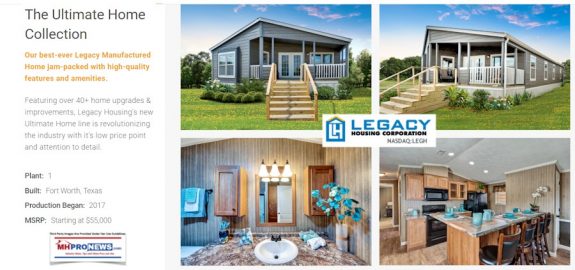
MHProNews points to ponder, in no particular order of importance:
· Terminology aside, several of the points made by Curt Hodgson and the investor cited above in the pull-quotes underscore reports that MHProNews and our MHLivingNews sister site have made for years.
· Several of the online stock analyst companies make comparisons between Cavco Industries and Legacy Housing. Cavco has had serious drama in the last year, while Legacy continues to work their plan without drama.
· Cavco has a much smaller percentage of stock held by insiders than Legacy does.
· Clayton Homes and their related lending also have several purported clouds over their heads; so while they have a wide lead, the possibility of consumer, legal and/or regulatory issues could prove challenging at some time in the foreseeable future.
The industry is underperforming, which means that those willing to put on the big boy pants and go to it – as Legacy is doing – can outperform others.

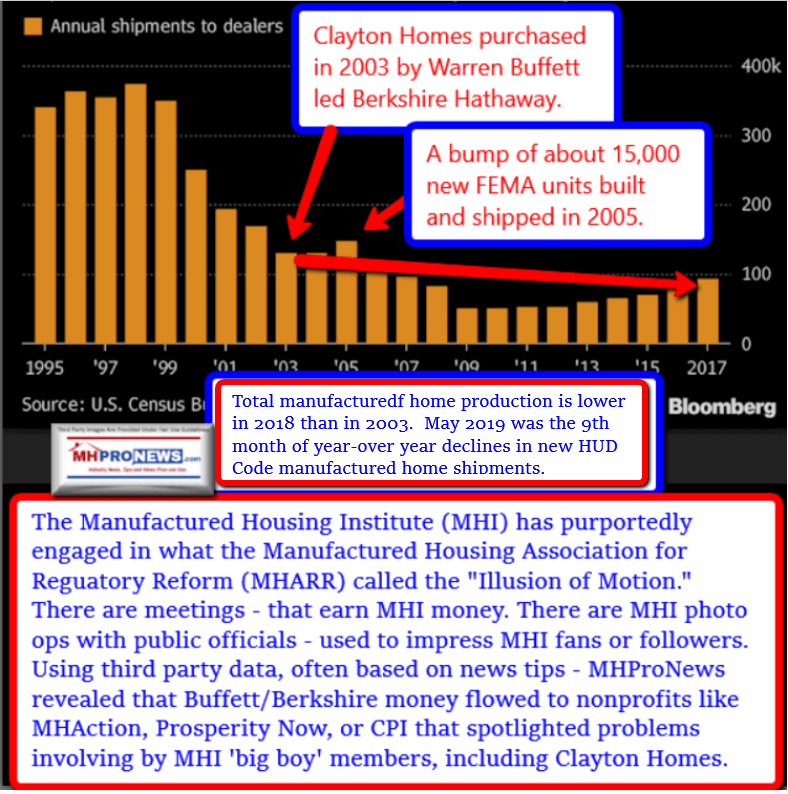
There is much more to unpack and digest, but a deeper dive into what follows could prove helpful. Keep in mind that several of those articles have their own cross links and downloads. Simply put, there is no one resource online that will give as much relevant insight as you will find here.
Related Reports
Countdown to Record-Setting ?! Wholesale Manufactured Home Show Event
Fannie Mae, Freddie Mac, Prosperity Now, “Following the Money” on Manufactured Home Lending Options
National Association of Realtors Research Exposes Manufactured Housing Institute Errors
“We Seem to Have Lost Common Sense,” HUD Secretary Ben Carson – Homeless, Affordable Housing Crisis

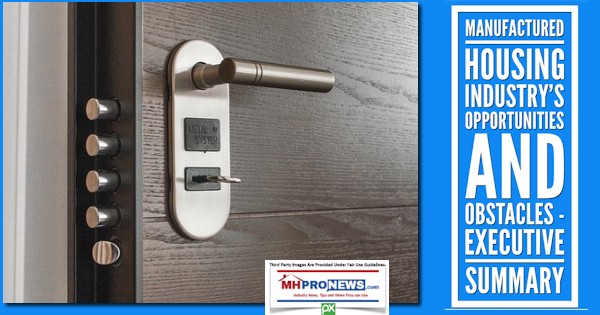
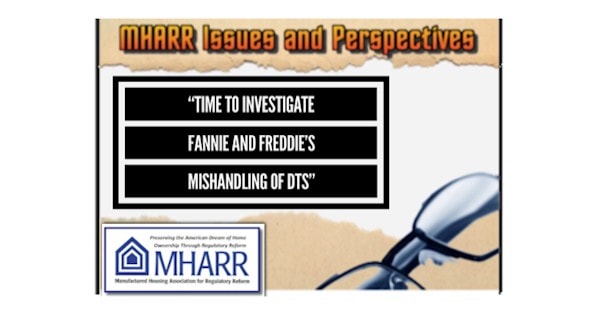

Manufactured Housing Industry Investments Connected Closing Equities Tickers
Some of these firms invest in manufactured housing, or are otherwise connected, but may do other forms of investing or business activities too.
- NOTE: The chart below includes the Canadian stock, ECN, which purchased Triad Financial Services.
- NOTE: Drew changed its name and trading symbol at the end of 2016 to Lippert (LCII).

Updated for Summer 2019…
Berkshire Hathaway is the parent company to Clayton Homes, 21st Mortgage, Vanderbilt Mortgage and other factory built housing industry suppliers.
· LCI Industries, Patrick, UFPI, and LP each are suppliers to the manufactured housing industry, among others.
· AMG, CG, and TAVFX have investments in manufactured housing related businesses.
Your link to an example of industry praise for our coverage, is found here and here. For the examples of our kudos linked above…plus well over 1,000 positive, public comments, we say – “Thank You for Your Vote of Confidence.”
· For expert manufactured housing business development or other professional services, click here.
· To sign up in seconds for our industry leading emailed headline news updates, click here.
Disclosure. MHProNews holds no positions in the stocks in this report.

(Image credits and information are as shown above, and when provided by third parties, are shared under fair use guidelines.)
Submitted by Soheyla Kovach, co-managing member of LifeStyle Factory Homes, LLC and co-founder for MHProNews.com, and MHLivingNews.com.
Connect with us on LinkedIn here and here.

























